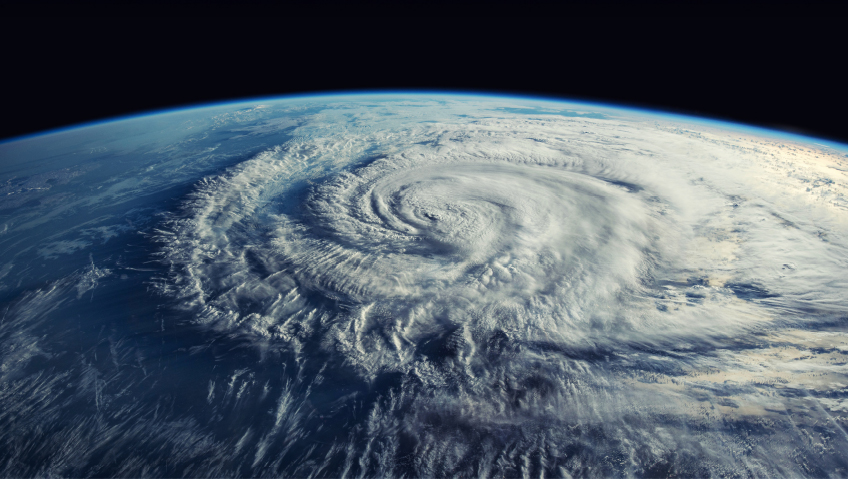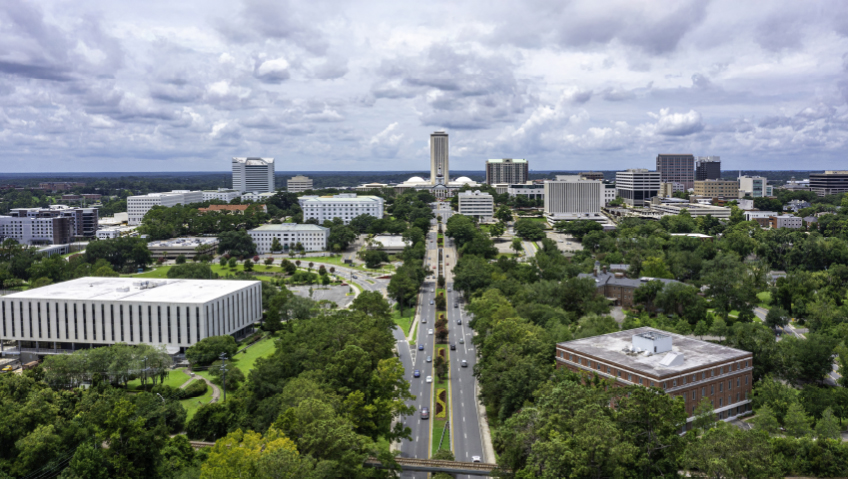On September 26th, 2024, Hurricane Helene slammed into the Big Bend area of the Florida Gulf Coast. The Category 4 storm ripped through the region, causing immense damage with 140-mile-per-hour winds and widespread flooding. Trees were uprooted, powerlines blew down, roads were washed away, and buildings were destroyed. Hundreds of thousands of people from Florida to North Carolina lost access to power for more than three weeks and to clean water for more than 50 days, according to the National Oceanic and Atmospheric Administration (NOAA).
Georgia’s agricultural sector lost billions of dollars, and the southern Appalachian Mountains were hit particularly hard, with parts of North Carolina, Tennessee, and Virginia suffering historic levels of flooding, landslides, and property damage. Hundreds of people died.
Now, nearly a year later, many mountain and rural roads are still washed out, creating ongoing logistical complications. Brush and other debris still litter the hillsides. Many places of business remain shuttered—if those buildings still stand at all. The total cost of Hurricane Helene comes in at a whopping $78.7 billion, according to the NOAA. Add to that the $34.3 billion caused by Category 5 Hurricane Milton, which hit Florida with a 10-foot storm surge, torrential rain, and at least 19 tornadoes just a month after Helene shook the region.
Now, the NOAA is predicting an “above-normal” hurricane season for 2025 with between 13 and 19 total named storms. Three to five of these are likely to be major hurricanes of category 3 or above. The national agency reports a 70 percent confidence in this forecast and warns that, as was the case last year, flooding could reach inland areas.
The Atlantic hurricane season lasts from June 1st to November 30th, the time of year when conditions are ideal for these super storms to form. This requires four elements: warm ocean water, a great deal of moisture in the air, low vertical wind shear, and a pre-existing weather disturbance, such as a cluster of thunderstorms, Angela Colbert, Ph.D., explains on NASA’s website. “Just like making a perfect cookie, a hurricane needs all the ingredients for it to grow,” she writes. “Change any ingredient too much and the cookie will be too flat, too dry, too crumbly. The same is true for hurricanes: if any of the four main ingredients changes too much, the storm cannot form or will weaken.”
Large-scale weather patterns determine where a hurricane will travel after it develops. These factors can include the complex El Niño and La Niña weather patterns in the Pacific Ocean, which strongly impact the hurricane season. “With so many moving parts, forecasting a hurricane is hard,” Dr. Colbert points out. Records of past hurricanes, advanced global climate models, and a scientific understanding of how hurricanes develop, travel, and strengthen all help scientists undertake the complex task of predicting upcoming hurricane seasons.
In November 2024, Science Advances published a study by the NOAA and other researchers that projects an “increase in the frequency of extremely active Atlantic hurricane seasons.” The study also predicts an increase in inactive hurricane seasons as well as fewer normal seasons. In other words, the researchers expect a large variability in future hurricane activity.
This exaggerated swing between the intensity of hurricane seasons ramps up the challenges that forecasters already face in predicting upcoming storms, and this phenomenon will put more pressure on emergency decision-makers as seasons vacillate between extremely dangerous and relatively peaceful. Businesses located in hurricane-prone areas should not be lulled into complacency by a quiet previous season. Instead, they should always be aware of the possibility of a tough one on the horizon.
Preparation is particularly crucial this year, when an overactive hurricane season has already been predicted. This means that many businesses are already known to be at risk of being impacted—potentially even ones that are not located on the coast, based on last year’s widespread destruction.
The most obvious potential impact is property damage. From high winds to storm surges and spawned tornados, hurricanes can wreak widespread havoc. But financial losses can go beyond physical repairs to include lost revenue due to closure. And, even if a business manages to reopen soon after a storm, it may still face challenges from supply chain disruption. Accuweather points out that road closures and power outages make it more difficult to receive inventory or ship products to customers, creating additional revenue loss and potentially damaging a company’s hard-earned reputation.
To help mitigate these potential losses, the Small Business Administration recommends a series of measures to take in advance. For starters, be sure to safeguard critical information. Store copies of paper documents—including insurance policies—in a location that will be safe from potential storm damage. Back up digital data and take the backup with you during an evacuation if the server is within the impact zone.
Inspect and repair any weaknesses in your business’s building before high winds, storm surges, and torrential rain strike. Have contractors lined up to call after a hurricane in case sudden repairs are needed.
A written crisis management plan lets employees know what to expect ahead of time. Regular emergency drills should be carried out with all employees, and contact information for employees, vendors, and customers should be accessible in the event of a power outage or evacuation. Identify employees who may be needed during a disaster and be sure they understand their responsibilities. Keep a stash of cash available in case it is needed to pay employees and contractors in the immediate aftermath. Consider purchasing a backup generator and know the best evacuation routes.
You will also need to review your insurance policies to know what they cover before a hurricane hits, since not all policies cover hurricane-related damage. In fact, there is no such thing as a single hurricane insurance policy; instead, property owners must cobble together multiple add-ons to be safe. The key is to make sure your business is protected against rain and wind, the two primary sources of damage from a hurricane. Most standard property insurance policies do not cover flooding, including from a storm surge, so any business located in a flood-prone area needs to be covered by a specific flood insurance policy. Policies do tend to cover wind damage—but only for buildings located far from high-risk areas. These policies may not cover wind damage in hurricane-prone coastal areas, so business owners in these places will likely need a separate windstorm policy.
If you need additional support, businesses at risk of hurricane damage can hire a logistics company to create an emergency plan and put it into place. These companies may also offer emergency services during an imminent risk, including securing the customer’s building, clearing debris, providing emergency food and clean water, and giving other essential help.
It is an unfortunate reality that hurricanes pose a major threat that business owners need to take seriously, particularly in light of this year’s projections for an active hurricane season. Fortunately, with careful planning and preparation, some of the risk can be mitigated—but only if measures are taken before the storm arrives.






